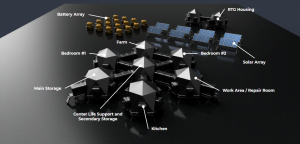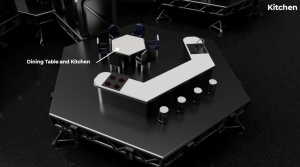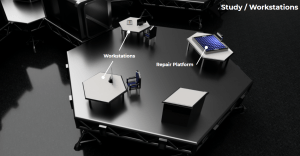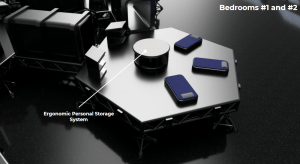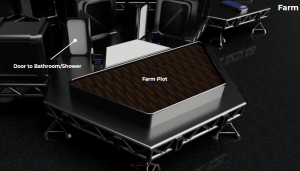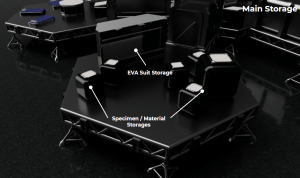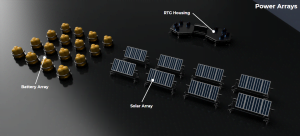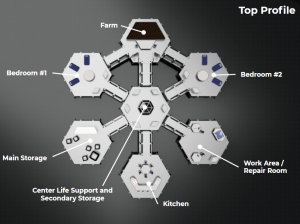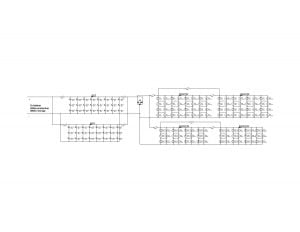Moon Camp Pioneers Gallery 2020-2021
In Moon Camp Pioneers each team’s mission is to 3D design a complete Moon Camp using Fusion 360. They also have to explain how they will use local resources, protect astronauts from the dangerous of space and describe the living and working facilities.
Team: Project ZLE
King Kekaulike High School Pukalani United States 16, 17
External viewer for 3d project
|
Project description
We have designed a moon camp with the intention of having an extremely safe, largely modular, and state of the art facility that could usher in a new era of lunar experimentation. At its core, we created a base with safety as the first priority. Nearly every system is triple-redundant, where just because one aspect goes awry, as things often do in new age space exploration, the whole system can continue functioning without error. Next, we set a goal on the entire system, not only the habs, being fully modular, but also secure. We took this into consideration and designed everything to be easily interchangeable in interior and exterior layouts, capable of being assembled and disassembled using but a humble drill. Finally, we incorporated some of the space industry’s most cutting edge designs in power and water culmination, as well as engineered some of our own technologies to tackle the moon’s harsh surface. |
|||
|
Where do you want to build your Moon Camp?
We chose to build our moon camp in the Southern Pole rim, in the Shackleton Crater. We chose this location because: 1) It is located far enough from the true pole to lessen the environmental effects of establishing a base at the pole such as radiation, winds, temperature changes, and lunar quakes. 2) The rims of this crater experience near constant sunlight, allowing for our solar farm to work at maximum capacity for as long as possible, only relying on other backup power sources when absolutely necessary. 3) The crater floor hosts an extremely low temperature, where there may be water frozen below the surface, acting as one of a few possible water sources for our base. 4) Exploration in the “perpetually dark” region of the crater’s center could yield possibilities of important scientific discoveries. How do you plan to build your Moon Camp? Describe the techniques and materials you would use.
We plan to assemble our moon camp by launching components from Earth and assembling them once on the surface of the Moon. The steel hexagonal base plates, supports, and lead and carbon fiber composite walls for each hab would be packaged in heat resistant filament and launched together, jettisoning from spacecraft orbiting the moon. Their descent would be slowed using thrusters similar to those used in NASA’s SkyCrane. The package, once firmly on the lunar surface, would mark its location, signaling it is ready for human interaction and assembly. A lander carrying the astronauts then would land within 50 meters of the site, allowing a support team of astronauts, assisted by robots and power tools, to assemble the base walls, and pressurize and oxygenate at least one module, where they could then regroup and prepare for further expansion of the base, as the mission required. The environment on the Moon is very dangerous for the astronauts. Explain how your Moon Camp will protect them.
For us, safety was above all in the design process. In almost every aspect of our design, we have at least two backups, in case a first aspect fails. We created, from scratch, a coilover-like suspension system to support the whole base. The main purpose behind this design would be to provide a dampening to moonquakes, but also create a level-able surface inside the hab, in case the base had to be placed slightly on an incline. We also chose to create a composite wall, using mostly light materials such as carbon fiber and fiberglass, with an outer layer of lead, to reflect radiation. Since we are not directly on the pole, we predict that this will be enough to prevent any lunar radiation from entering the hab, and if in practical testing, it proves to not be, extra layers of lead infused paint or filament could be added to the exterior of the base. Explain how your Moon Camp will provide the astronauts with:
|
|||
|
Water
|
Food
|
Electricity
|
Air
|
|
To provide our researchers with water, our base requires a reserve of water to be brought from Earth to begin with. With this reserve, we plan on using a distillation process and dehumidification of the atmosphere to reclaim water. As like the process used on the Space Station, this process should be 99% efficient, so only small amounts of water need to be sent from earth. On top of that lunar ice is going to be collected and reassured so the lunar ice can be filtered and used as an alternative water source. One water reclaimer can filter enough water for 6 people a day and there are 3 reclaimers for triple redundancy. |
Since it costs $10,000 per pound of payload to send to space, reducing the amount of produce that would be required to be shipped was imperative for us. To make the most of our funds, we will need to grow as much food as possible in the base. One of the easiest foods to grow that delivers the most calories is potatoes, so we have a designated crop cultivation section of our hab that will have all the requirements to grow food. |
Power is one of the most important parts of any space habitat, and to solve this important problem, we considered what options would yield the most power using the least space. The two methods we chose were solar and nuclear power, along with high capacity lithium batteries like those used on the International Space Station. Next, in order to figure out how many of each production process we would need, we figured out how much power the base required in a default 7 HAB configuration. We figure if our base is roughly twice the size of the ISS, so it will need to be capable of producing twice as much power. If the ISS is capable of producing 120 kilowatts of power at full load, we need our base to be able to produce 240 kilowatts. We ended up needing 24 nuclear generators (8 reactors) and 32 solar generators (8 panels) along with 48 batteries (16 groups). |
To provide oxygen to the hab we have a triple redundant oxygenator setup that creates 12lbs of oxygen per oxygenator. This setup can comfortably support 6 people. The oxygeninators create oxygen by taking in CO2 and turning it into O2. |
|
Explain what would be the main purpose of your Moon Camp (for example: commercial, scientific, and/or tourist purposes).
Our moon camp is designed to be modular, meaning that it could be set up to accommodate many different circumstances or purposes. In the way we have it set up now, the moon camp is intended solely for scientific use, since much of the equipment onboard is extremely sensitive and would require special training to handle or operate safely. |
|||
|
Describe a day on the Moon for your Moon Camp astronaut crew.
To begin a day in our camp, the three researchers in each sleep cycle (group) would wake up, and on the way to the kitchen, do check-ups on crucial life support and oxygenating equipment. Once they have had their meals, each researcher would go to his assigned task, primarily making sure all crucial systems are normal, but also cultivating crops, researching specimens, repairing broken equipment, or any other task the day might bring on. After the first group is finished and the second group wakes, both teams would converse on the day’s successes and challenges, and based on this information, the second team would finish anything the first crew was unable to, and continue in this type of cycle. |
|||


